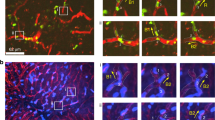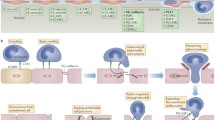Summary
During the first 10 minutes after the onset of metamorphosis in the ascidian Amaroucium constellatum there is a massive emigration of blood cells (granulocytes) from the hemocoel, across the epidermis, into the tunic. Electron microscopy has been employed to extend some of the classical observations of the last century. The new findings are compatible with the hypothesis that the blood cells follow a transcellular pathway. Our interpretation is as follows: an emigrating cell enters the basal part of an epidermal cell and becomes enclosed within a vacuole. The vacuole and the blood cell move to the apex of the epidermal cell. The vacuole fuses with the plasmalemma releasing the blood cell into the tunic. Blood cells can therefore pass through the epidermis without leaving a hole and without rupturing intercellular junctions.
Similar content being viewed by others
References
Azema, M.: Recherches sur le sang et l'excrétion chez les ascidies. Ann. Inst. Oceanog. 17, 1–150 (1937).
Berrill, N. J.: Metamorphosis in ascidians. J. Morph. 81, 249–267 (1947).
—: The tunicata with an account of the British species. London: The Ray Society 1950.
Bradway, W.: The experimental alteration of the rate of metamorphosis in the tunicate Clavelina huntsmani (Van Name). J. exp. Zool. 62, 213–224 (1936).
Brien, P.: Contribution a l'étude de la régénération naturelle et expérimentale chez les Clavelinidae. Ann. Soc. roy. zool. Belg. 61, 19–112 (1930).
Cloney, R. A.: Cytoplasmic filaments and cell movements: Epidermal cell during ascidian metamorphosis. J. Ultrastruct. Res. 14, 300–328 (1966).
—: Cytoplasmic filaments and morphogenesis: The role of the notochord in ascidian metamorphosis. Z. Zellforsch. 100, 31–53 (1969).
Conklin, E. G.: The development of centrifuged eggs of ascidians. J. exp. Zool. 60, 1–119 (1931).
Dilly, P. N.: The Ultrastructure of the test of the tadpole larva of the test of the tadpole larva of Ciona intestinalis. Z. Zellforsch. 95, 331–346 (1969).
Grave, C.: Metamorphosis of Ascidian larvae. Carneg. Inst. Wash. Publ. No. 452, 209–292 (1935).
Grave, C., Nicoll, P.: Studies of larval life and metamorphosis in Ascidia nigra and species of Polyandrocarpa. Carneg. Inst. Wash. Publ. No 517, 1–46 (1939).
Grimm, L. M., Cloney, R. A.: Ultrastructural study of ascidian metamorphosis: Blood cell migration across the epidermis. Amer. Zoologist 5, 644 (1965).
Hirai, E.: Initiating effect on metamorphosis of vital staining of tadpole larvae of an ascidian Halocynthia roretzi (V. Drasche). Bull. Mar. Biol. Sta. Asamushi 10, 189–192 (1961).
Holmgren, E.: Ein Beitrag zum experimentellen Studium der Clavelina Metamorphose. Arch. Entwickl.-Mech. Org. 129, 199–205 (1933).
Humbel, J. G., Jayne, W. H. W., Pulvertaft, R. J. V.: Biological interaction between lymphocytes and other cells. Brit. J. Haematol. 2, 283 (1956).
Kowalevsky, A. O.: Einige Beiträge zur Bildung des Mantels der Ascidien. Mem. Acad. Sci. St. Petersb. 38, 1–20 (1892).
Ling, N. R., Acton, A. B., Roitt, I. M., Doniach, D.: Interaction of lymphocytes from immunized hosts with thyroid and other cells in culture. Brit. J. exp. Path., 46, 348–359 (1965).
Luft, J. H.: Improvements in epoxy resin embedding methods. J. biophys. biochem. Cytol. 9, 409–414 (1961).
Lynch, W. G.: Extrinsic factors influencing metamorphosis in bryozoan and ascidian larvae. Amer. Zoologist 1, 59–66 (1961).
Marchesi, V. T.: The site of leucocyte emigration during inflammation. Quart. J. exp. Physiol. 46, 115–118 (1961).
—, Gowans, J. L.: The migration of lymphocytes through the endothelium of venules in lymph nodes: an electron microscope study. Proc. roy Soc. B 159, 283 (1964).
Revel, J. P., Karnovsky, M. J.: Hexagonal array of subunits in intercellular junctions of the mouse heart and liver. J. Cell Biol. 33, C7-C12 (1967).
Reynolds, E. S.: The use of lead citrate at high pH as an electron-opaque stain in electron microscopy. J. Cell Biol. 17, 208–212 (1963).
Richardson, K. C., Jarrett, L., Finke, E. H.: Embedding in epoxy resins for ultrathin sectioning in electron microscopy. Stain Technol. 35, 313–323 (1960).
Salensky, W.: Morphologische Studien an Tunicaten. II. Über die Metamorphose der Distaplia magnilarva. Morph. Jb. 20, 449–542 (1893).
Scott, Sister F. M.: The developmental history of Amaroecium constellatum. III. Metamorphosis Biol. Bull. 103, 226–241 (1952).
Seeliger, O.: Einige Beobachtungen über die Bildung des äußeren Mantels der Tunicaten. Z. wiss. Zool. 56, 488–505 (1893).
- Hartmeyer, E.: Tunicata (Manteltiere). In: Bronn's Thier-Reichs Suppl. III, Leipzig (1893–1911).
Trowell, O. A.: The lymphocyte. Int. Rev. Cytol. 7, 235–293 (1958).
Weiss, P.: Experimentelle Untersuchungen über die Metamorphose der Ascidien I. Beschleunigung des Metamorphoseeintrittes durch Thyreoideabehandlung der Larve. Biol. Zbl. 48, 69–79 (1928).
Whittaker, J. R.: Copper as a factor in the onset of ascidian metamorphosis. Nature (Lond.) 202, 1024–1025 (1964).
Zhinkin, L.: Experimental studies on the larvae of ascidia. Acta zool. (Stockh.) 20, 212–238 (1939).
Author information
Authors and Affiliations
Additional information
This investigation was supported in part by National Science Foundation Research Grant GB 5394. The authors thank Dr. John S. Edwards for stimulating discussions and for critically reading the manuscript.
A part of this investigation was carried out at the Friday Harbor Laboratories of the University of Washington. The cooperation of the Director, Dr. Robert L. Fernald in facilitating this work is greatly appreciated.
Rights and permissions
About this article
Cite this article
Cloney, R.A., Grimm, L. Transcellular emigration of blood cells during ascidian metamorphosis. Z. Zellforsch. 107, 157–173 (1970). https://doi.org/10.1007/BF00335222
Received:
Issue Date:
DOI: https://doi.org/10.1007/BF00335222




